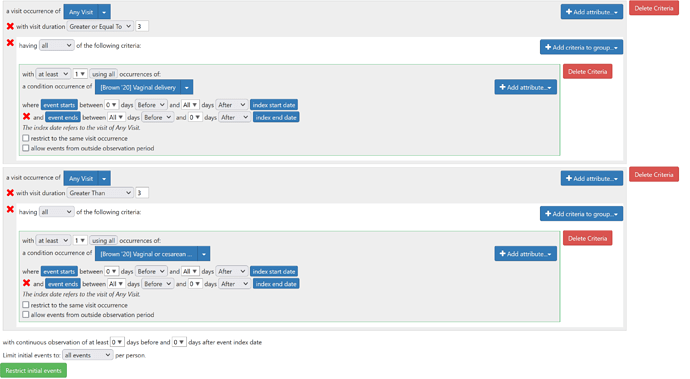- 915,DistinctMeasurementCountMediumTerm,ConceptCounts.sql,mediumTermStartDays,endDays,distinct,Measurement,measurement,measurement_concept_id,measurement_date,measurement_date,FALSE,The number of distinct measurements observed in the medium term window.
- 916,DistinctMeasurementCountShortTerm,ConceptCounts.sql,shortTermStartDays,endDays,distinct,Measurement,measurement,measurement_concept_id,measurement_date,measurement_date,FALSE,The number of distinct measurements observed in the short term window.
- 917,DistinctObservationCountLongTerm,ConceptCounts.sql,longTermStartDays,endDays,distinct,Observation,observation,observation_concept_id,observation_date,observation_date,FALSE,The number of distinct observations observed in the long term window.
- 918,DistinctObservationCountMediumTerm,ConceptCounts.sql,mediumTermStartDays,endDays,distinct,Observation,observation,observation_concept_id,observation_date,observation_date,FALSE,The number of distinct observations observed in the medium term window.
- 919,DistinctObservationCountShortTerm,ConceptCounts.sql,shortTermStartDays,endDays,distinct,Observation,observation,observation_concept_id,observation_date,observation_date,FALSE,The number of distinct observations observed in the short term window.
- 920,VisitCountLongTerm,ConceptCounts.sql,longTermStartDays,endDays,all,Visit,visit_occurrence,visit_concept_id,visit_start_date,visit_end_date,FALSE,The number of visits observed in the long term window.
- 921,VisitCountMediumTerm,ConceptCounts.sql,mediumTermStartDays,endDays,all,Visit,visit_occurrence,visit_concept_id,visit_start_date,visit_end_date,FALSE,The number of visits observed in the medium term window.
- 922,VisitCountShortTerm,ConceptCounts.sql,shortTermStartDays,endDays,all,Visit,visit_occurrence,visit_concept_id,visit_start_date,visit_end_date,FALSE,The number of visits observed in the short term window.
- 923,VisitConceptCountLongTerm,ConceptCounts.sql,longTermStartDays,endDays,stratified,Visit,visit_occurrence,visit_concept_id,visit_start_date,visit_end_date,FALSE,"The number of visits observed in the long term window, stratified by visit concept ID."
- 924,VisitConceptCountMediumTerm,ConceptCounts.sql,mediumTermStartDays,endDays,stratified,Visit,visit_occurrence,visit_concept_id,visit_start_date,visit_end_date,FALSE,"The number of visits observed in the medium term window, stratified by visit concept ID."
- 925,VisitConceptCountShortTerm,ConceptCounts.sql,shortTermStartDays,endDays,stratified,Visit,visit_occurrence,visit_concept_id,visit_start_date,visit_end_date,FALSE,"The number of visits observed in the short term window, stratified by visit concept ID."



